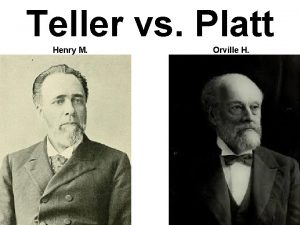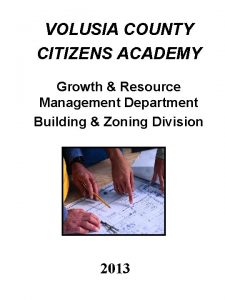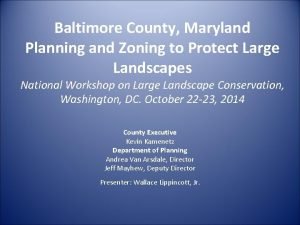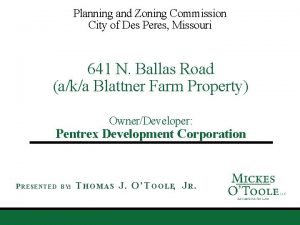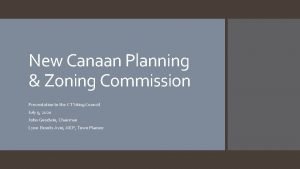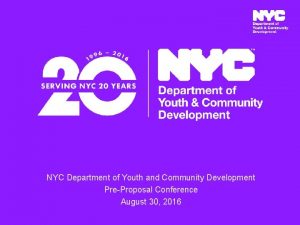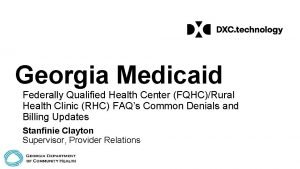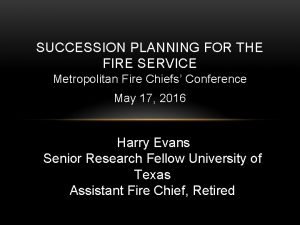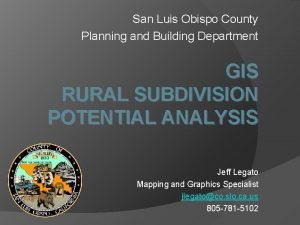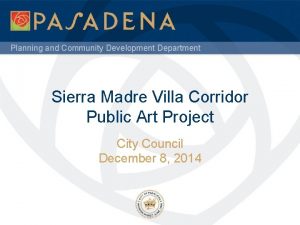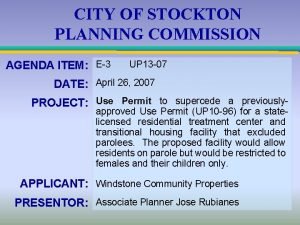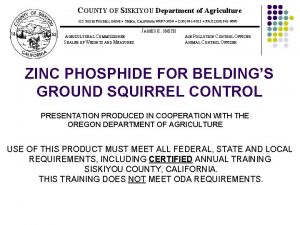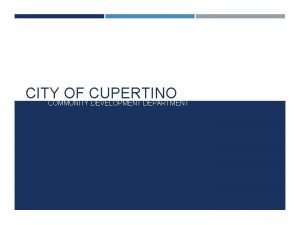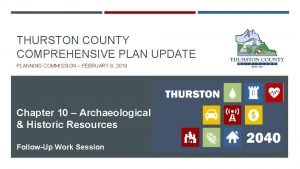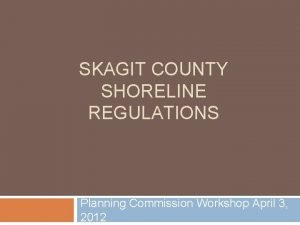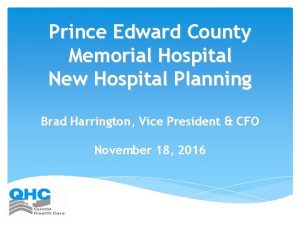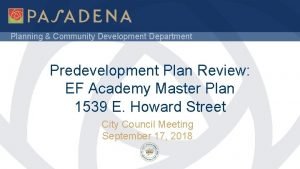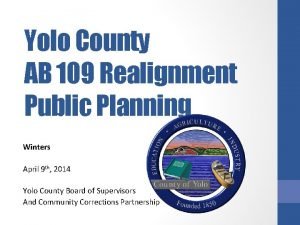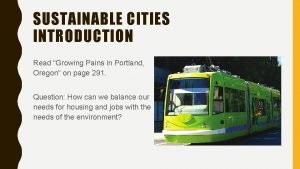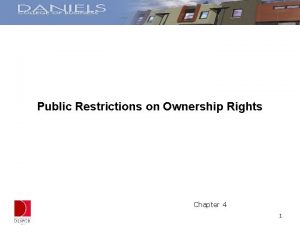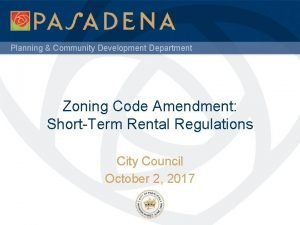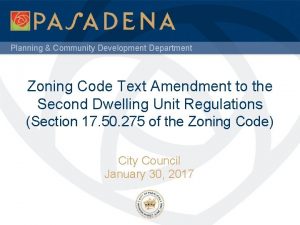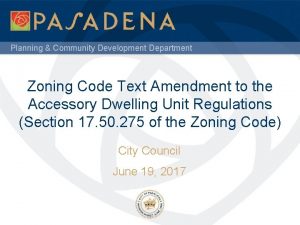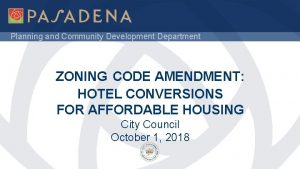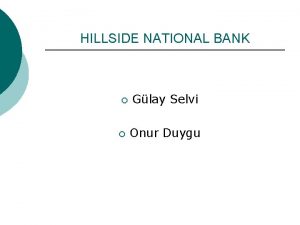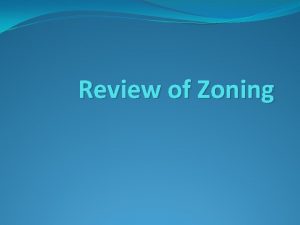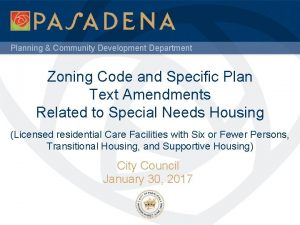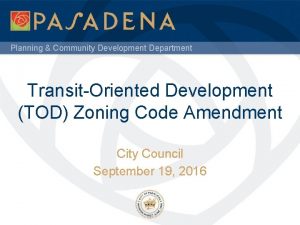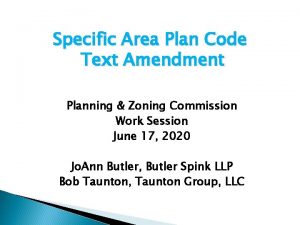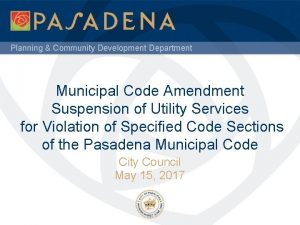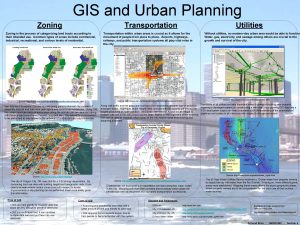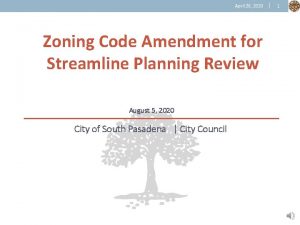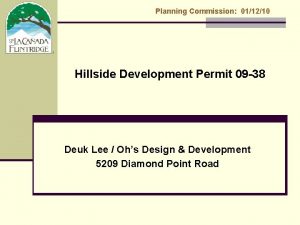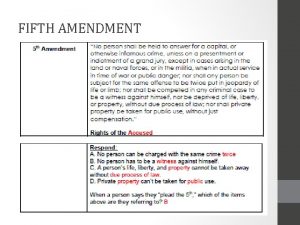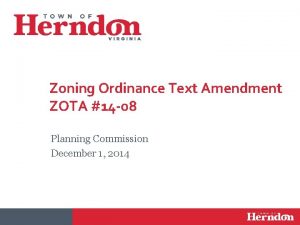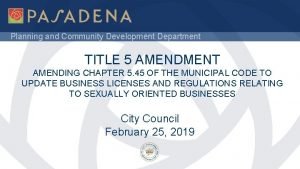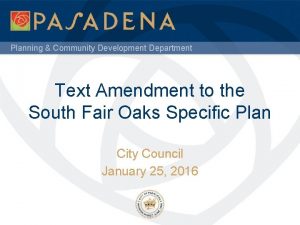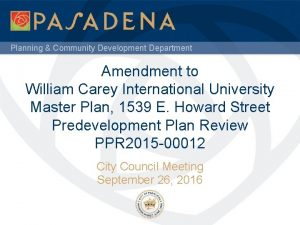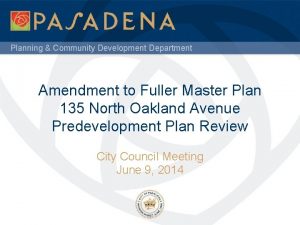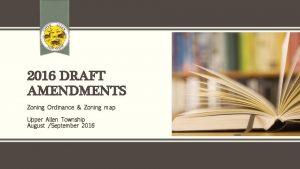Planning Community Development Department Zoning Code Amendment Hillside































- Slides: 31

Planning & Community Development Department Zoning Code Amendment: Hillside District Overlay Zones City Council June 19, 2017

Recommendation Planning & Community Development Department • Recommend City Council: 1) Find that the proposed Zoning Code Amendment is exempt from the California Environmental Quality Act (CEQA) pursuant to Section 15308 (Class 8, Actions by Regulatory Agencies for Protection of the Environment); 2) Approve of Findings for Zoning Code Amendments; 3) Approve the proposed Amendments to Section 17. 29 (Hillside Overlay District) of the Zoning Code; and 4) Direct the City Attorney to prepare an ordinance within 60 days amending Title 17 of the Pasadena Municipal Code (Zoning Code) Section 17. 29 (Hillside Overlay Districts). 2

Council Initiation Planning & Community Development Department • Project initiated by City Council in 2014 in response to community concern regarding potential for “mansionization” of single-family residential neighborhoods. • Three-Phase effort: > Phase 1 – Lower Hastings Ranch (completed February 2017) > Phase 2 – Citywide, non-historic, non-hillside (estimated completion in Fall 2017) > Phase 3 – Hillside Overlay Districts (presented tonight) 3

Map of Hillside District overlay zones Planning & Community Development Department HD-1 HD HD-SR 4

Background Planning & Community Development Department • Community Outreach > March – June 2015 § Eight citywide meetings > March 2016 § Three Hillside Community Meetings > April - June 2016 § Meetings with Neighborhood Association representatives > September 2016 § Two Hillside Community Meetings § Meetings with Neighborhood Association representatives > October 2016 § Meetings with Neighborhood Association representatives 5

Background Planning & Community Development Department • Planning Commission Study Session – November 2016 > Staff presented Planning Commission with summary of community input, draft solutions and potential code amendments. > Planning Commission requested a workshop to allow for more direct interaction between the Commission and public. • Planning Commission Workshop – January 2017 > Discussion of existing regulations, issues identified by residents and possible solutions. > Planning Commission requested a second workshop to provide public with additional opportunity for participation. • Planning Commission Workshop #2 – February 2017 > Continued discussion of existing regulations, issues identified by residents, and possible solutions. 6

Background Planning & Community Development Department • Planning Commission Hearing – April 26, 2017 • Commission voted to recommend approval of the proposed Zoning Code Amendment, with the following modifications: > If Zoning Code Amendment is adopted, return to the Planning Commission in 18 months for status update; > Retain P. M. C. Section 17. 29. 080(G), which allows an applicant to seek adjustment to any Hillside District development standard and which had been recommended for removal by staff; and > Request that staff consider a minimum house size below which a project would not be subject to maximum house size calculation in Section 17. 29. 060(D), Neighborhood Compatibility. 7

Community Concerns Planning & Community Development Department • Oversized Houses and Additions • Overdevelopment of Hillside Areas • View Protection • New Structures and Renovations that are incompatible with surroundings 8

Oversized Houses and Additions: Floor Area - Upper Hastings Ranch Planning & Community Development Department • Residents concerned about houses and additions that are too large/out of scale. • Solutions: > Upper Hastings Ranch (HD-1) currently has no maximum Floor Area Ratio (FAR) requirement. Currently regulated only by Lot Coverage (maximum 35% of the lot). > Staff proposes to require a maximum FAR that is consistent with the base zoning of Upper Hastings Ranch (RS-4 and RS-6). § Site less than 12, 000 s. f. – 30% + 500 s. f. § Site of 12, 000 to 24, 000 s. f. – 20% + 1, 700 s. f. § Site greater than 24, 000 s. f. – 25% + 1, 000 s. f. > Provides an additional safeguard against potential mansionization of the neighborhood. 9

Oversized Houses and Additions: Hillside Development Permit thresholds Planning & Community Development Department • Solutions: Change HDP Thresholds > The following types of projects currently require HDP review: § Proposed subdivisions § A new dwelling or structure § Additions to an existing dwelling or structure > However, several types of projects are currently exempt: § Single-story additions less than 500 square feet, or 20% of the existing floor area of the primary structure (including attached garage), whichever greater. § Second or third-story additions less than 500 square feet. § Single-story accessory structure no larger than 20% of the existing floor area of the primary structure (including attached garage). > Staff proposes to retain existing project types and expand HDP requirement for any single-story addition larger than 500 square feet. Second/third story additions would always require HDP. 10

Oversized Houses and Additions: Neighborhood Compatibility Standards Planning & Community Development Department • Discussion: > Neighborhood Compatibility section in the Zoning Code (Section 17. 29. 060. D) intended to ensure that new houses and additions are sensitive to the character and scale of surrounding neighborhood. > Defines a 500 -foot “neighborhood” for purposes of analyzing a proposed project. > Specifies that allowable floor area of a house shall not exceed 35 percent above the median floor area of houses within a 500 foot radius, except in certain cases. > Guidelines were adopted by the City Council in 2006 (Resolution #8697) to assist decision makers in implementing Neighborhood Compatibility standards. 11

Oversized Houses and Additions: Neighborhood Compatibility Guidelines Planning & Community Development Department • Solutions: > Staff proposes to codify the adopted Neighborhood Compatibility Guidelines: § The 500 -foot “neighborhood” is defined in the Zoning Code. The Guidelines were adopted to allow for modification of the neighborhood in cases where: » Properties within 500 feet are not in Pasadena; » Properties within 500 feet are not in a Hillside Overlay District; » Properties within 500 feet are not in an RS district, or a different RS district; or » Properties within 500 feet are separated by significant manmade structures (e. g. freeway) or by significant natural features (e. g. canyon, ridge) that to the extent determinable by staff are not the result of grading or other manmade alteration of the natural terrain. 12

Oversized Houses and Additions: Neighborhood Compatibility Guidelines Planning & Community Development Department • Guidelines also allow for maximum allowable house size to exceed Neighborhood Compatibility on a case-by-case basis. • Staff proposes to add qualification thresholds and additional findings to assist decision makers in determining when it may be appropriate to exceed Neighborhood Compatibility: > Threshold: § Minimum lot size of 20, 000 square feet; > Findings: § No additional view impacts will occur to neighboring properties as a result of granting additional square footage; and § The massing, scale, and building articulation of the proposed dwelling or other structure is compatible with the neighborhood as viewed from public or private streets. 13

Overdevelopment of Hillside Areas: Basements Planning & Community Development Department • Residents concerned about basements that are too large, as well as location of basements on a property. • Solutions: > Limit basement size to the footprint of an existing or proposed house. > Limit basement depth to one level, maximum interior height of nine feet. > Basements to be prohibited underneath accessory structures. 14

Overdevelopment of Hillside Areas: Accessory Structures Planning & Community Development Department • Residents concerned about size of accessory structures. • Solutions: > Limit maximum size of accessory structures (individual) to 600 square feet. > For lots with more than one accessory structure, retain existing limit on total size to no more than 600 square feet or six percent of lot size, whichever is greater. > For lots over 10, 000 square feet, deduct portions with slope greater than 50 percent from lot size when determining total size of accessory structures. 15

View Protection Planning & Community Development Department • Residents concerned about definition of “Primary Living Areas” in terms of view protection. • Recommendation: > Revise language to allow views to be considered from any room, instead of only certain rooms (living room, family room, patios). 16

View Protection Planning & Community Development Department • Residents concerned about definition of “Primary Living Areas” in terms of view protection. • Recommendation: > Proposed clarification stating that views of open sky, existing foliage, and neighboring structures are not considered in view determination. > Revised graphics to be placed in the Zoning Code, similar to graphics at right, depicting preferred and discouraged view scenarios. 17

View Protection Planning & Community Development Department • Planning Commission concern regarding the requirement that a project not block views “to the maximum extent feasible” and criteria used to determine view blockage. • Recommendation: > Provide clarification guidelines to assist decision makers in applying discretion when approving or disapproving projects and considering view impacts: § The ability of the project to physically relocate the building to another part of the property; § The ability of the project to alter the massing away from surrounding properties’ views; and § The ability of the project to minimize architectural features that may intrude upon views from surrounding properties. 18

View Protection Planning & Community Development Department • Recommendation: > Provide decision makers with ability to grant adjustments to standards in cases where the standards would prevent a structure from reducing or eliminating a view impact. > The decision maker must make two findings (in addition to HDP findings): § The adjustment is necessary to minimize or eliminate impacts to a neighbor’s view of culturally significant structures (e. g. Rose Bowl, Colorado street bridge), city lights, prominent ridgelines, or the horizon line. § Granting the adjustment will not unreasonably alter the streetfacing character of the neighborhood or unreasonably disrupt the continuity of established front yard setbacks. 19

View Protection Planning & Community Development Department • Residents concerned about understanding potential view impacts of two-story structures on neighboring properties. • Solution: > Currently, Hillside Development Permit applications must include one of the following types of visual analysis: § § § Digital and/or artistic renderings Temporary silhouettes (story poles) Photomontages Computer-generated photo simulations Three-dimensional scale model Any other technique acceptable to the Zoning Administrator > Staff recommends making story poles and renderings mandatory for two-story projects. 20

View Protection (Continued) Planning & Community Development Department • Residents concerned about understanding potential view impacts of two-story structures on neighboring properties. • Solution: > For all two-story projects: > Provide additional notice to neighbors within 500 feet of project site. > “Notice of Application” to be sent out, once project application is deemed complete. > Allows additional time for public to submit comments regarding potential view impacts prior to Hearing Officer consideration. 21

New Structures and Renovations that are incompatible: Accessory Structures Planning & Community Development Department • Residents concerned about location of accessory structures. • Solutions: > Limit location of all accessory structures to behind the rear wall plane of the main house. § Exception for detached garages. 22

New Structures and Renovations that are Incompatible: Major Renovations Planning & Community Development Department • Residents concerned about projects that change the character of an existing house and involve major construction work, but do not currently require public notification or review. • Solution: > Create “Major Renovation” thresholds as part of the Hillside Development Permit process. > Thresholds would be: § Altering more than 50% of exterior wall façades by reducing walls down to the framing; or § Any alteration of the roofline resulting in an increase in height above the highest point of the existing roof. > A project that includes either of the above activities would require a Hillside Development Permit. 23

Recommendation Planning & Community Development Department • Recommend City Council: 1) Find that the proposed Zoning Code Amendment is exempt from the California Environmental Quality Act (CEQA) pursuant to Section 15308 (Class 8, Actions by Regulatory Agencies for Protection of the Environment); 2) Approve of Findings for Zoning Code Amendments; 3) Approve the proposed Amendments to Section 17. 29 (Hillside Overlay District) of the Zoning Code; and 4) Direct the City Attorney to prepare an ordinance within 60 days amending Title 17 of the Pasadena Municipal Code (Zoning Code) Section 17. 29 (Hillside Overlay Districts). 24

Planning & Community Development Department Zoning Code Amendment: Hillside District Overlay Zones City Council June 19, 2017

Adjustments to Hillside District Development Standards (17. 29. 080. G) Planning & Community Development Department • Applicants may seek adjustments to any Hillside District Development standard as part of a HDP. • To approve an adjustment, Hearing Officer must find that: > The adjustments result in a project that is less visible from off-site; and > The adjustments result in a project that has less environmental impact on wildlife, habitat, slopes, or existing scenic views than it would if it complied with the development standards. • Staff originally proposed to remove this section to eliminate unintended consequences. • Planning Commission opted to retain section to allow for flexibility where appropriate due to new restrictions. 26

Color Requirements (17. 29. 060. C. 4) Planning & Community Development Department • Projects that require a Hillside Development Permit currently are limited to “dark tones, including earth tones”. • Some comments by residents that dark earth tones are not appropriate for certain architectural styles (e. g. Spanish Revival, Colonial, etc. ). • After consideration of current requirements, community comments, and Planning Commission discussion, staff recommended no change to existing standards. 27

Lot Sizes – 10, 000 square feet Planning & Community Development Department Total: 4, 944 10, 000 s/f and up (2, 583) Under 10, 000 s/f (2, 361) 28

Lot Sizes – 15, 000 square feet Planning & Community Development Department Total: 4, 944 15, 000 s/f and up (1, 770) Under 15, 000 s/f (3, 174) 29

Lot Sizes – 20, 000 square feet Planning & Community Development Department Total: 4, 944 20, 000 s/f and up (1, 292) Under 20, 000 s/f (3, 652) 30

Lot Sizes – 40, 000 square feet Planning & Community Development Department Total: 4, 944 40, 000 s/f and up (437) Under 40, 000 s/f (4, 507) 31
 Platt amendment definition
Platt amendment definition Volusia county planning and zoning
Volusia county planning and zoning Baltimore county planning
Baltimore county planning Lighthouse on the hillside
Lighthouse on the hillside Orchestra, theatron, parados
Orchestra, theatron, parados What is wind blasting sand at rock and carving out arches
What is wind blasting sand at rock and carving out arches Garden state water testing
Garden state water testing 10 happy shepherds dancing on the hillside
10 happy shepherds dancing on the hillside Pentrex development
Pentrex development New canaan zoning regulations
New canaan zoning regulations Wakulla planning and zoning
Wakulla planning and zoning Department of youth and community development
Department of youth and community development Busceral
Busceral Historical perspective of community development
Historical perspective of community development Georgia department of community health
Georgia department of community health Ts planning
Ts planning Fire department succession planning
Fire department succession planning City of san luis obispo planning department
City of san luis obispo planning department Sierra madre planning department
Sierra madre planning department City of stockton planning commission
City of stockton planning commission Siskiyou county planning department
Siskiyou county planning department City of cupertino planning department
City of cupertino planning department Thurston county planning department
Thurston county planning department Skagit county planning commission
Skagit county planning commission Prince edward county planning department
Prince edward county planning department Pasadena planning department
Pasadena planning department Temecula planning department
Temecula planning department Yolo county planning department
Yolo county planning department Wilmington planning department
Wilmington planning department Briefly describe how city planners use zoning
Briefly describe how city planners use zoning St. marys county land use and zoning lawyer
St. marys county land use and zoning lawyer Inverse condemnation
Inverse condemnation
